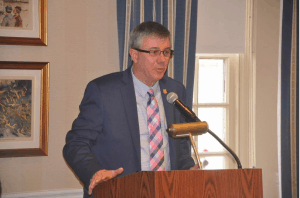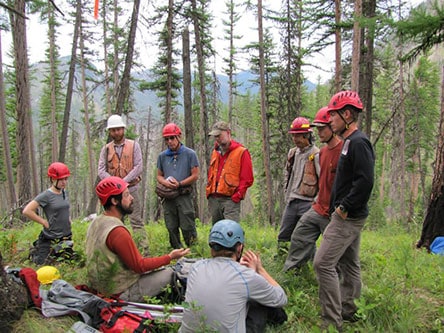Dr. Martin Nie is not only the director of the distinguished Bolle Center for People and Forests at the University of Montana…but Dr. Nie was one of the founders of this blog. The Missoulian article also includes quotes from current blog contributor Jon Haber. – mk
Forest Service tried to quash paper debunking Montana wildlife authority
By Rob Chaney, Missoulian | Full article here
The U.S. Forest Service has disavowed a legal analysis it commissioned that showed federal land managers have given state wildlife departments more authority than they really possess.
In June, the agency asked the University of Montana to remove the draft report five days after “Fish and Wildlife Management on Federal Lands: Debunking State Supremacy” appeared on the Bolle Center for People and Forest’s website.
Three weeks later, it terminated a two-year contract with the center and its director, Martin Nie, citing the “provocative title” as a reason.
“This is some of the most tedious, boring work I’ve ever done,” Nie told a group of UM students Wednesday. “That’s what’s amazing — how much controversy this has generated.”
The beehive Nie and his colleagues whacked concerns who owns and controls wildlife in the nation: state fish and game departments or federal land managers.
In 126 pages of Supreme Court citings, legislative history and case studies, the Bolle team argued that “the U.S. Constitution grants the federal government vast authority to manage its lands and wildlife resources … even when states object.”
“The myth that ‘the states manage wildlife and federal land agencies only manage wildlife habitat’ is not only wrong from a legal standpoint but it leads to fragmented approaches to wildlife conservation, unproductive battles over agency turf, and an abdication of federal responsibility over wildlife,” the report stated. It found that claim “especially dubious when states assert ownership as a basis to challenge federal authority over wildlife on federal lands.”
One case study Nie looked at took place just over the Montana border last winter. An Idaho Department of Fish and Game helicopter team trapped and radio-collared two wolves in the Frank Church-River of No Return Wilderness while ostensibly conducting an elk study. The action violated several requirements of the federal Wilderness Act as well as a federal court warning against such activities. In June, a federal judge ordered Idaho to destroy all the elk and wolf data gathered from the study and chastised the Forest Service for allowing the project to go forward.
“Congress has no interest in usurping the role of states in managing hunting and fishing,” Nie said. “But the federal government can’t say it doesn’t manage public land just because they don’t want to manage the take of big-game animals. What’s baffling to us was we reminded them they have the power, and they don’t seem to want to hear it.”
Forest Service officials at the Rocky Mountain Research Station in Fort Collins, Colorado, and in Washington, D.C., did not respond to requests for comment on this story Friday. A spokesperson said they may be able to discuss the issues next week.
Nie stressed the report didn’t call for a federal claw-back of authority over wildlife. Rather, it suggested a more constructive “co-trusteeship” that balances state management goals with federal obligations to conserve all kinds of fish and wildlife in the public trust.
Take it down
Nie’s team posted a draft version of the study on June 2 on the Bolle Center’s website for feedback and criticism before sending it for publication in Environmental Law, a law review at Lewis & Clark Law School dedicated to environmental issues.
Five days later, Rocky Mountain Research Station Director John Phipps contacted Franke College of Forestry and Conservation Dean Tom DeLuca and asked him to take down the report. Nie said Phipps told him, “I hope that the consequences of this decision will not be as serious as I fear they will be.”
DeLuca declined to remove the report.
“To be told you have to take that down or face consequences — that sure seems like censorship to me,” DeLuca said. “No other Forest Service research project we have has encountered something like this, and we have a very close relationship with the Forest Service. I don’t know Phipps personally, but we’ve always had a very positive relationship. When he says ‘consequences,’ I don’t know how to interpret that. Does he mean for the college or for Martin?”
Lucy France at UM’s Office of Legal Counsel said the university has and intends to continue its positive working relationship with the Forest Service. But it also considers Nie a well-respected faculty member and scholar, and supports the academic freedom of all its faculty.
“The university supports, and to the extent it can be helpful, will continue to help facilitate continuing dialogue between Dr. Nie and the U.S. Forest Service,” France said. “The university position is that neither it nor Dr. Nie did anything to violate the terms of the joint venture agreement.”
DeLuca said UM and the Forest Service have deeply interwoven research ties, with more than $2 million a year in joint venture agreements and related funding supporting student and faculty activity.
On June 26, Phipps sent a letter to UM stating that the Forest Service was terminating Nie’s contract. Phipps stated the contract required all work to be produced in collaboration with the agency, and “to date, the Forest Service has not collaborated on the content of any final or draft reports or other publications produced(.)”
Nie found this confusing. He had been invited to formally brief Forest Service leadership in Washington, D.C., twice in 2015 and 2016 while the research was in progress (for the first time in his career).
He added that the contract laid out what the Forest Service was supposed to do on its end: “I fail to understand the rationale of terminating an agreement based on a perceived failure of the USFS, not by me and my research team,” he wrote to Phipps.
Phipps followed up on July 27 with a clarification letter. He wrote the agency wasn’t accusing Nie of failing to carry out the obligations of the contract: “Rather at the time the decision was made to terminate the agreement, the Forest Service simply had not seen the results of any research or content of any draft or final work product.” Phipps added the agency “looks forward to working with Dr. Nie” and UM on future projects.
That further confounded matters. “On what basis would you ask that the article be taken offline if the agency had not yet seen it?” Nie asked.
On August 30, Forest Service Deputy Chief for Research and Development Carlos Rodriguez-Franco wrote Nie another response.
“The concerns which led to the termination … arose when a draft article, with a provocative title challenging state legal authorities, was placed on a public website without prior substantive comment from the Forest Service,” Rodriguez-Franco wrote.
“(I)t became apparent that the work being conducted by the University was entering the realm of legal services — including interpreting the Constitution, laws and court cases as they pertain to the administration of Forest Service programs — rather than scientific research.”
The Forest Service, he explained, was required by law to get its legal advice from the federal Office of General Counsel.
But the contract itself never asked for scientific research. It requested “an authoritative review of the policy-legal issues related to wildlife management on federal lands … to explain the more relevant public land laws, regulations, case law, agreements and plans relevant to fish and wildlife management on federal lands and wilderness(.)”
The contract came from the Aldo Leopold Wilderness Research Institute, a Forest Service-funded center that Nie can see from his office on the fourth floor of UM’s Clapp Science Center. Center Director Susan Fox wrote Phipps a letter supporting Nie and protesting the contract termination.
“Blue-ribbon panels are used when it is important that they are independent from political influence or agency authority,” Nie quoted from Fox’s letter to Phipps. “Blue-ribbon panels are often appointed by government to report on a matter of controversy.”
What’s the controversy?
Nie described the final version of the report as “four parts Nyquil and one part Red Bull.” It charts the legal reasoning from dozens of federal court cases confirming that federal law trumps state law where wildlife is concerned. It also chronicles the history of states carving out exceptions to that federal authority, or challenging federal oversight when it conflicts with state plans.
For example, the U.S. Fish and Wildlife Service in 2016 attempted to protect grizzly bears and wolves on national wildlife refuges from hunting practices promoted by Alaska’s state predator control policy to boost elk, moose and caribou populations. Congress this year used the Congressional Review Act to nullify the FWS regulations, although it didn’t take away the agency’s obligation to protect predators on its lands.
The underpinning for public land management is something called the North American Model of Wildlife Conservation. Nie’s work poked that historic philosophy of big-game hunting.
The North American Model dates back to the 1860s, when habitat loss to settlement and commercial hunting of wildlife for sale drove much of the continent’s deer and elk off the landscape. Hunting advocates, including Theodore Roosevelt and George Bird Grinnell, helped lead a movement to professionalize wildlife management and preserve habitat.
As noted in the Missoula-headquartered Rocky Mountain Elk Foundation’s website, the model has two core principles. “That our fish and wildlife belong to all Americans, and that they need to be managed in a way that their populations will be sustained forever.”
Montana’s five-week, general big-game hunting season stands testament to the success of the idea. The state enjoys one of the longest and most liberal opportunities to kill deer, elk, black bears, fish and antelope anywhere in the continental U.S. Its Department of Fish, Wildlife and Parks gets almost all its funding directly from hunters and anglers through the sale of licenses and permits to hunt and fish.
The problem, according to the study, is that approach assumes the point of public wildlife is to serve the needs of the community that hunts it. That perspective excludes or demotes the needs of non-game animals, people who watch but don’t hunt, ecosystems that depend on a balance of predators and prey, and places that don’t support popular game animals.
“When we got into all those cases, we were surprised to see the states constantly citing this (North American) model,” Nie said. “They’ve been making these arguments for a century. But the constitutional issues have been resolved for a long time.”
Nevertheless, the presumption got woven into federal policy without proper support. For example, federal Bureau of Land Management policy 43 CFR Part 24 states in part: “BLM lands … explicitly recognized and reaffirmed the primary authority and responsibility of the States for management of fish and resident wildlife on such lands.” In fact, Nie argued, underlying federal law does not grant such state primacy.
Montana Fish, Wildlife and Parks Director Martha Williams said that tension is a constant factor in land management.
“In these political times, looking at wildlife management and public lands is timely and, frankly, tricky,” Williams said. “I firmly believe in public trust wildlife. It’s a responsibility that states, especially Montana, need to take seriously. I think the authors are asking for more understanding of the need for collaboration between the states and federal government on wildlife.”
Giving states ownership of public wildlife also pushes the federal government out of the land-management arena. DeLuca said that may be a clue to why the report generated such a swift shut-down.
“It’s more than just the title,” DeLuca said. “It’s the content of the work and the definitive conclusion that there’s no primacy of states over wildlife. That pushes against the supposed agenda to shift responsibility for federal land management down to the states.”
The report documents efforts by organizations like the Association of Fish and Wildlife Agencies to cement state primacy into federal law. It noted that AFWA has been attempting that “through legally questionable policy channels and nontransparent agreements between federal agencies and (AFWA).” Montana FWP is a member of AFWA.
The ideas also show up in bills like the Sportsmen’s Heritage and Recreational Enhancement Act, which passed out of the House Natural Resources Committee on Sept. 13. The bill blocks federal restrictions on lead ammunition and fishing tackle and gives states expanded approval of federal fishing restrictions, among other things. Its final section, “Respect for State Wildlife Management Authority,” states: “Nothing in this act shall be construed as interfering with, diminishing, or conflicting with the authority, jurisdiction or responsibility of any State to exercise primary management, control or regulation of fish and wildlife under State law, on land or water within the State, including on Federal land administered by the Bureau of Land Management or the Forest Service.”
“Some of us were aware of the SHARE Act, but we chose not to include that in the scope of paper,” report co-author Jon Haber said. “It wasn’t targeted at the SHARE Act or other legislation. This is information that could be used anywhere. That’s all it was intended to be.”
Haber is a retired Forest Service planning specialist. He was joined in the project by Christopher Barnes, recently retired wilderness specialist from BLM’s Carhart Center, and Kenneth Pitt, a retired attorney from the USDA Office of General Counsel. On the academic side, Nie brought in law professor Sandra Zellmer and former University of Alaska associate professor Julie Joly.
Nie opted to keep the dispute quiet over the summer, hoping to get an explanation of the Forest Service’s reaction and perhaps an apology. At one point, it appeared the agency was going to provide a formal review through its Office of General Counsel. That fizzled after several weeks of anticipation. It wasn’t until students asked about the project at the start of the fall semester that he decided to air the dispute publicly.
At Wednesday’s gathering, UM environmental sociologist Jill Belsky played devil’s advocate and asked about the decision to keep the “debunking” title. If the goal was to promote better state and federal cooperation, getting silenced by a federal agency wasn’t the intended outcome.
Nie said the team considered changing the title. But once they got the order to take the paper offline, they dug in.
“This is what we do,” Nie said. “These are myths, and they need to be debunked. If they can’t get past a title, there’s no hope the agencies will ever change.”


